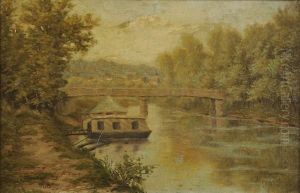Pierre Blanchard Paintings
Pierre Blanchard, not to be confused with the pioneering balloonist of the same name, was a French artist known for his skill in miniature painting. Born in 1772, Blanchard's life spanned a period of significant political and social change in France, which included the French Revolution, the Napoleonic era, and the Restoration period.
Blanchard's artistic career began in the late 18th century, and he became a pupil of the renowned painter Jacques-Louis David. Under David's tutelage, Blanchard refined his skills and developed a precise and delicate style that was well-suited to miniature painting, a popular art form during this period. Miniature painting was highly prized for its intricate detail and was often used for personal portraits, typically worn as jewelry or kept in small, private albums.
Throughout his career, Blanchard exhibited his work at the Paris Salon, the official art exhibition of the Académie des Beaux-Arts in Paris. His miniatures were appreciated for their elegance and clarity of detail, and he became one of the sought-after miniaturists of his time. Despite the turbulent political climate, Blanchard managed to maintain a successful career, catering to the tastes of the French aristocracy and later the growing bourgeoisie.
Blanchard's work often reflects the neoclassical style that was predominant at the time, characterized by a return to classical antiquity's simplicity, harmony, and proportion. This was in stark contrast to the previous Rococo style, which was known for its ornate and decorative qualities.
Unfortunately, unlike some of his contemporaries, Blanchard did not achieve the same enduring fame after his death in 1856. His works, while still appreciated by art historians and collectors of miniatures, do not occupy the same prominent position in the canon of French art as those of his master, Jacques-Louis David, or other prominent artists of the era. Nevertheless, Blanchard's miniatures are valuable for their technical proficiency and as a testament to the tastes and aesthetics of his time.
